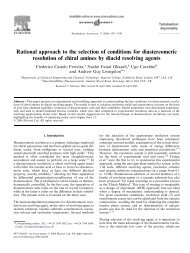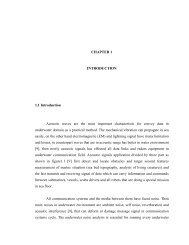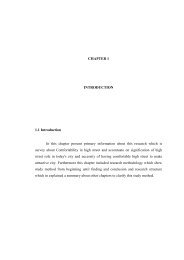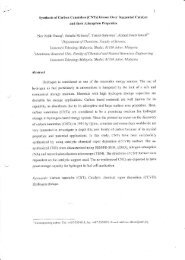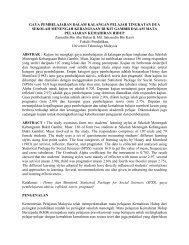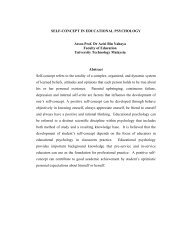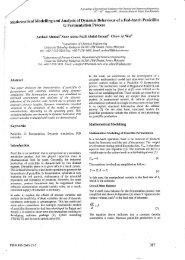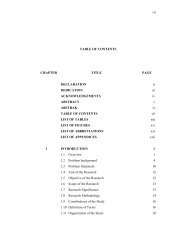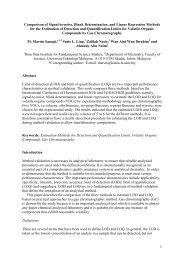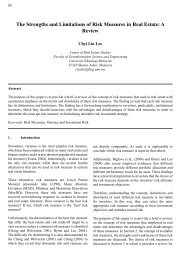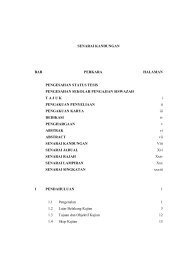Modern Portfolio Theory: Is There Any Opportunity for Real Estate ...
Modern Portfolio Theory: Is There Any Opportunity for Real Estate ...
Modern Portfolio Theory: Is There Any Opportunity for Real Estate ...
You also want an ePaper? Increase the reach of your titles
YUMPU automatically turns print PDFs into web optimized ePapers that Google loves.
14<br />
<strong>Modern</strong> <strong>Portfolio</strong> <strong>Theory</strong>: <strong>Is</strong> <strong>There</strong> <strong>Any</strong> <strong>Opportunity</strong> <strong>for</strong> <strong>Real</strong> <strong>Estate</strong><br />
<strong>Portfolio</strong>?<br />
Abstract<br />
Hishamuddin Mohd Ali, Ph.D<br />
Department of Property Management<br />
Faculty of Geoin<strong>for</strong>mation Science and Engineering<br />
Universiti Teknologi Malaysia<br />
81310 Skudai<br />
hisham@fksg.utm.my<br />
<strong>Modern</strong> <strong>Portfolio</strong> <strong>Theory</strong> (MPT) has become the backbone of finance as it gives better understanding of the best possible<br />
investment portfolio <strong>for</strong> financial assets. Since the idea was introduced by Harry Markowitz about five decades ago,<br />
the applicability of MPT to real estate analysis have been widely discussed by many real estate researchers with some<br />
pro and con outcomes. As MPT was developed through some “unrealistic” assumptions, the results from previous<br />
studies could not give a decisive generalisation of real estate investment decisions. This paper presents the issues<br />
of the applicability and implication of employing MPT on real estate portfolio analysis. The discussion is merely<br />
looking into some previous empirical studies with mixture of findings. The new paradigm of real estate investment<br />
has been shifted from ‘tactical and operational’ to ‘strategic and tactical’ style of management. <strong>There</strong><strong>for</strong>e, MPT could<br />
give a sound analytical view of real estate portfolio analysis which may offer more opportunities <strong>for</strong> further research<br />
particularly in Malaysia.<br />
Keywords: <strong>Portfolio</strong> <strong>Theory</strong>, <strong>Real</strong> <strong>Estate</strong> <strong>Portfolio</strong>, CAPM, Asset Allocation<br />
1. Introduction<br />
Since Markowitz (1959) introduced <strong>Modern</strong> <strong>Portfolio</strong><br />
<strong>Theory</strong> (MPT), many researchers have attempted to model<br />
the benefits of establishing diversification strategies<br />
<strong>for</strong> portfolio investments. MPT is part of the branch<br />
of finance known as Investment Management. Most of<br />
the applications of MPT deal with paper investments<br />
such as stocks, bonds, options and futures rather than<br />
real investment like corporate investment projects and<br />
real property. Early works focused on potential gains<br />
from combining different stocks into a single portfolio,<br />
but since then, research has been extended to bonds,<br />
currencies, real estate, and international stocks and<br />
bonds. MPT is one of the theoretical breakthroughs in<br />
financial research and has had a profound impact on the<br />
practice of investment management.<br />
Diversification has been a vast issue since MPT has been<br />
accepted as a tool in managing real estate portfolio. As<br />
real estate carries a large proportion of specific risk,<br />
diversification in real estate investment has become more<br />
important than be<strong>for</strong>e. As such, the applicability of MPT<br />
in real estate portfolio has been widely debated by many<br />
researchers. The purpose of this article is to explore<br />
the implications and applicability of MPT in real estate<br />
portfolios. The next sections will discuss the environment<br />
of real estate investment with a comparison of real estate<br />
and share markets. The article proceeds by discussing the<br />
application of portfolio and capital market theories on<br />
real estate. The most important aspects, including issues<br />
on the implementation and application of MPT, will be<br />
highlighted, as well as the implications on real estate<br />
research.
2. The Environment of <strong>Real</strong> <strong>Estate</strong> Investment<br />
<strong>Real</strong> estate has its own characteristics, which significantly<br />
affect the environment of real estate portfolio management.<br />
Unlike real estate investment, stocks, bonds and other<br />
paper investments are purchased merely <strong>for</strong> investment<br />
purposes; whereas investors purchase real estate <strong>for</strong> an<br />
operational purpose including <strong>for</strong> capital appreciation.<br />
For example, some people prefer to pay the instalment<br />
of buying a house rather than paying the rental with<br />
expectation that the value may increase in the future.<br />
Heterogeneity is probably the main feature of real<br />
estate interests that <strong>for</strong>med real estate portfolio at its<br />
own characteristic. The real estate portfolio seems very<br />
difficult to construct compared to other sectors. For<br />
instance, every real estate carries its own unique location,<br />
even two similar terrace houses which are built next to<br />
each other.<br />
Unlike other investment media, a large amount of capital<br />
is required to acquire land and buildings. Investors in the<br />
capital market have a wide choice of well-documented<br />
issues of paper securities and may invest in the new<br />
issues or purchase in the market (Scarrett, 1991). <strong>Any</strong>one<br />
involved in real estate transaction is unable to divide<br />
his or her investment into small units. <strong>There</strong><strong>for</strong>e, real<br />
estate transaction involves transferring legal interests by<br />
which the costs of transfer are invariably relatively high<br />
(Millington, 1995). The costs include taxes on transfer<br />
such as stamp duty, real property gain tax, advertising,<br />
estate agent and legal fees and professional opinion of<br />
value by which are substantially higher compared to the<br />
transaction costs in the capital market.<br />
A fundamental economic feature of real estate is the<br />
inelasticity of supply (Enever and <strong>Is</strong>aac, 1994). Planning<br />
control, building construction and finance arrangement<br />
causes the supply to react slowly to increases in demand.<br />
The public-listed company or government can issue<br />
more shares or bonds in the capital market to fulfil their<br />
demand. The description of supply and demand shows<br />
that the transactions of real estate market are small but<br />
the amount of money involved is generally high. The<br />
in<strong>for</strong>mation on transactions is quite limited and not<br />
efficient to respond to any news or data that will affect<br />
the real estate market.<br />
The daily transactions of the capital market can be easily<br />
retrieved from various sources, <strong>for</strong> instance through<br />
daily reports in newspapers and screen-based computer<br />
systems such as Bloomberg, which easily accessible in<br />
the library of Bursa Malaysia. The real estate price and<br />
return can only be constructed yearly and monthly, but<br />
usually based on appraised real estate values (Hassan,<br />
1990).<br />
15<br />
Imperfection of the real estate market is unable to help<br />
the potential purchaser or seller where it only represents<br />
many local markets rather than one large market. The<br />
participants themselves have extremely divergent<br />
expectations on real estate in that they might have their<br />
own reasons and strategies <strong>for</strong> any real estate acquisition.<br />
Other reason cited by Roulac (1978) <strong>for</strong> real estate market<br />
inefficiency is the uniqueness and lack of comparability<br />
among various types of real estate investments. Although,<br />
the capital and real estate market operate differently,<br />
both of them exhibit their own market trends even if<br />
they are highly correlated. It is still dubious whether the<br />
capital market returns will be good indicators <strong>for</strong> real<br />
estate returns. Financial decision tools can reasonably<br />
be employed <strong>for</strong> real estate valuation and investment,<br />
provided the in<strong>for</strong>mation is adequate to develop the<br />
valuation models. Further discussion regarding the<br />
relationship between real estate market and stock market<br />
is in the next section.<br />
3. <strong>Real</strong> <strong>Estate</strong> Market versus Stock Market<br />
The question of whether real estate and stock markets is<br />
integrated or not is important in measuring per<strong>for</strong>mance.<br />
Both the real estate and stock markets’ activities <strong>for</strong>m<br />
significant elements in business cycle fluctuations.<br />
A common approach has been to study the separate<br />
influences of each market on business cycle activity.<br />
The study of price volatility on the stock market has a<br />
rich history, with recent studies focusing on the use of<br />
single equation time series models in the identification<br />
of speculative bubbles (Dezhbakhsh and Demirguc-<br />
Kunt, 1990; Evans, 1991; Topol, 1991), and tests of the<br />
mean reversion hypothesis and its use in predicting stock<br />
market volatility (Engel and Moris, 1991; Jegadeesh,<br />
1991; Kim et al., 1991; Randolph, 1991). Sagalyn<br />
(1990) and Hartzell and Mengdon (1987) found a<br />
positive correlation between dividends produced by a<br />
<strong>Real</strong> <strong>Estate</strong> Investment Trust (REIT) portfolio and the<br />
cash flows from the Prudential <strong>Real</strong> <strong>Estate</strong> Investment<br />
Separate Account. However, contrary to expectations, no<br />
significant correlation was found between the National<br />
Council of <strong>Real</strong> <strong>Estate</strong> Investment Fiduciaries (NCREIF)<br />
Index cash flows and REIT dividends. More studies<br />
emphasise the relationship between real estate returns<br />
and stock price returns by correlation tests on return<br />
components such as cash flow, yield rates (Moss and<br />
Schneider, 1996; Mueller and Laposa, 1995) and other<br />
variables producing returns (Gyourko and Kim, 1992;<br />
Young, 1994).<br />
In the US, many studies have focused on the nature of<br />
REIT returns owing to their common use as proxies<br />
<strong>for</strong> real estate returns (McCue and Kling, 1994). Some<br />
studies have attempted to relate REIT returns to other<br />
measures of real estate returns such as the NCREIF Index
16<br />
returns. Giliberto (1990) studied the relationship between<br />
the National Association of <strong>Real</strong> <strong>Estate</strong> Investment<br />
Trusts (NAREIT) Equity Index returns and the NCREIF<br />
Index returns. Giliberto found no significant correlation<br />
between the NCREIF Index returns and the NAREIT<br />
returns. In order to remove non-real estate variation from<br />
the two series, Giliberto regressed both the NCREIF<br />
Index returns and NAREIT Equity Index returns on<br />
stock market, bond market, and seasonal variables.<br />
Giliberto found the residuals of the two regressions<br />
were significantly correlated, which suggesting there is<br />
extraneous variation masking the correlation. Giliberto<br />
also found that the NCREIF Index residuals were<br />
correlated with lags of the NAREIT residuals. The<br />
separate regressions were partially removing the effects<br />
of time and seasonality from the series.<br />
Gyourko and Keim (1992) analysed the relationship<br />
between the NCREIF Index returns and REIT returns,<br />
concluding that REIT returns did correlate on a lagged<br />
basis with the NCREIF Index returns. Gyourko and<br />
Keim noted the problems with volatility, appraisal timing<br />
and appraisal smoothing in the NCREIF Index returns.<br />
The authors argue that due to infrequent appraisals,<br />
the NCREIF Index is slow to react to macro economic<br />
in<strong>for</strong>mation. They argue that transaction-based series,<br />
such as REIT returns, react quickly to new in<strong>for</strong>mation<br />
and should there<strong>for</strong>e lead the NCREIF Index.<br />
<strong>Real</strong> estate company per<strong>for</strong>mance and direct real estate<br />
per<strong>for</strong>mance can identify the linkage between real estate<br />
market and stock market. In the UK, this has been an area<br />
of considerable interest in recent years (Barkham and<br />
Geltner, 1995; Eichholtz and Hartzell, 1996; Lizieri and<br />
Satchell, 1997; Newell et al., 1997; Venmore-Rowland,<br />
1990; Wang, 1998). Typically, UK real estate company<br />
per<strong>for</strong>mance has been poorly correlated with direct real<br />
estate but highly correlated with shares. This trend has<br />
also been evident in many other countries (eg: USA,<br />
Australia, Hong Kong).<br />
4. <strong>Modern</strong> <strong>Portfolio</strong> <strong>Theory</strong> and Capital Asset<br />
Pricing Model<br />
The literature on MPT in real estate analysis is<br />
considerable and contains many important studies of<br />
its suitability and application to establish an optimal<br />
allocation of property portfolios (Friedman, 1971; Draper<br />
and Findlay, 1982). In the early days of the acceptance of<br />
property as one of the asset classes, most of the studies<br />
dealt with stocks and bonds and generally did not include<br />
real estate investments. The main reason stems from<br />
the unavailability of a centralised market <strong>for</strong> real estate<br />
where continuous in<strong>for</strong>mation on real estate markets is<br />
provided. Hassan (1990) noted in one of his conclusions<br />
on the relationship between real estate analysis and MPT<br />
that real estate assets generally outper<strong>for</strong>m stocks and<br />
bonds in risk and return measurement. He added real<br />
estate assets provide excellent diversification potential<br />
<strong>for</strong> portfolio investors and also a good inflation hedge.<br />
Mean-variance optimisation indicates that, to achieve the<br />
ideal trade off between risk and return, 9 to 20 per cent of<br />
pension fund assets should be in real estate (Brown and<br />
Schuck, 1996; Fiedler, 1992; Fogler, 1984; Hoesli and<br />
Hamelink, 1996; Kallerg et. al., 1996; MacGregor and<br />
Nanthakumaran, 1992; Sweeney, 1988). Most pension<br />
funds today only allocate about 5% of their portfolio in<br />
real estate equity assets (Smith, 1992). Obviously, real<br />
estate is an under-utilised asset class. Why is real estate<br />
under utilised when it offers such proven opportunities<br />
to minimise risk and simultaneously accomplish an<br />
acceptable return? Such investment characteristics<br />
certainly offer opportunities <strong>for</strong> diversification that are<br />
incomparable with other asset classes. MPT has also<br />
something to offer in Malaysian perspective. Hishamuddin<br />
et al. (2003) found that by adding Malaysian real estate<br />
investment trust (REIT) in the investment portfolio<br />
can provide higher return at the same level of risk. In<br />
other words, by including listed REIT in the investment<br />
portfolio would offer better per<strong>for</strong>mance.<br />
The important issue on the problem of direct real estate<br />
investment is the lack of liquidity compared with the<br />
other major investment media (McAllister and Mansfield,<br />
1998; Smith, 1992). The main reasons are due to large<br />
lot size, high transaction costs, no central marketplace,<br />
infrequency of real estate transactions and delay due to<br />
legal work. In simple terms, this means that the original<br />
capital will not always be as quickly obtainable when<br />
desired. The problem of relative illiquidity influences the<br />
attractiveness of real estate as an asset class. Illiquidity<br />
restricts the portfolio managers’ ability to switch<br />
between real estate and other asset classes. Moreover,<br />
the restructuring programme of the real estate portfolio<br />
in response to changing perceptions of sectoral and<br />
geographical per<strong>for</strong>mance potential will be limited.<br />
Illiquidity relative to the other major asset classes<br />
indirectly reduces the investor’s ability to apply <strong>for</strong>mal<br />
portfolio theory to real estate portfolio decisions.<br />
Misjudgement of real estate investments has driven most<br />
of the institutional investors not to invest more in real<br />
estate. <strong>Portfolio</strong> managers who are familiar with the<br />
financial markets are often less confident in the real estate<br />
market. Many portfolio managers tend to misjudge real<br />
estate investments and the result is that property, more so<br />
than other types of investment, suffers from a number of<br />
myths and misunderstandings.<br />
The arguments regarding the characteristics of real<br />
estate investment have driven most large institutions to
adapt MPT as a standard tool <strong>for</strong> understanding how<br />
the real estate holdings behave, whether independently<br />
or as part of the overall investment holdings. The aim<br />
of applying MPT is to create a portfolio of investments<br />
that produces predictable return. Risk in this system is<br />
defined as volatility of return. The idea of the application<br />
of MPT to real estate is interesting, as its allows real<br />
estate managers to understand both what to expect from<br />
real estate investments as a whole, and how those real<br />
estate holdings fit into the overall portfolios. However,<br />
can MPT be successfully applied to real estate, and how<br />
can that be done? <strong>There</strong> has been some disagreement<br />
regarding the suitability of applying MPT to real estate.<br />
According to Young and Grieg (1993), it has been<br />
proved mathematically that real estate is unsuitable <strong>for</strong><br />
MPT analysis, as real estate is heterogeneous and the<br />
real estate market is illiquid and dissimilar to the stock<br />
market. They have added that MPT is an inaccurate<br />
guide <strong>for</strong> real estate asset allocation because investment<br />
returns depend on varying circumstances of investment<br />
properties. However, they compared the per<strong>for</strong>mance of<br />
two completely different properties and not surprisingly<br />
the returns of the two properties are definitely different.<br />
They conclude that diversification by real estate type and<br />
location factors may be insufficient to predict expected<br />
returns. Nevertheless, suggestions have been made by<br />
Young and Grieg (1993) by which further research and<br />
more complex models of the interaction between real<br />
estate and other investment portfolios are required be<strong>for</strong>e<br />
MPT can be employed to real estate.<br />
This debatable issue was brought up among real estate’s<br />
leading portfolio management experts in the US when<br />
they had the opportunity to face the “father of MPT”,<br />
Harry Markowitz, in a ‘roundtable’ sponsored by<br />
Buildings (Reinbach, 1993). In that historical meeting<br />
with Markowitz, Reinbach (1993) quoted what had been<br />
addressed by Markowitz - real estate can be explained<br />
and measured with financial theory tools, subject to a<br />
number of issues about the subject. The most identifiable<br />
factor is the lack of reliable real estate data. Stock and<br />
bond market data have been sufficient to deal with<br />
any investment management tools, especially when<br />
daily transactions take place with many cyclical price<br />
movements. However, most of the real estate market<br />
data were derived from a valuation-based index. Another<br />
problem with real estate is the effect of illiquidity on<br />
pricing and waiting <strong>for</strong> a best price.<br />
For the moment, most academics and practitioners<br />
have accepted MPT as a standard tool to examine the<br />
behaviour of real estate holding. From time to time, the<br />
understanding of MPT has been improved alongside a<br />
number of assumptions and suggestions that have been<br />
made by several studies. Most of the studies had suggested<br />
that portfolio management within real estate asset class<br />
17<br />
or sector allocation should be made upon the differences<br />
of geographical and real estate-type (Geurts and Nolan,<br />
1997; Pagliari et. al., 1995). However, the suggestions<br />
could not satisfy most of the academics and practitioners.<br />
At least this is a good start in order to develop and create<br />
a stand-alone real estate theory to explain real estate<br />
per<strong>for</strong>mance, instead of applying other investment media<br />
tools to real estate.<br />
MPT has undergone a revolution in the last five decades.<br />
The subsequent discussion will be the fundamental<br />
ideas of the inevitable trade-off between risk and return,<br />
illustrated by the capital asset pricing model (CAPM).<br />
Return and risk are defined and illustrated, and total<br />
risk is shown to be made up of market risk and specific<br />
risk in relation to real estate. Market risk is unavoidable<br />
because it arises from movements in the economy as a<br />
whole; the specific risk relating to individual real estate<br />
can be removed by diversification, and efficient capital<br />
markets will there<strong>for</strong>e offer no rewards <strong>for</strong> specific risk.<br />
Diversification thus makes sense <strong>for</strong> investors, because<br />
they can avoid specific risk.<br />
For many years, investment advisers and investment<br />
managers focused on returns with the occasional caveat<br />
‘subject to risk’. MPT concentrates on risk at least as<br />
much as return. In fact, MPT could be described as risk<br />
management, rather than return management. Decision<br />
can be made about the risks which portfolio managers<br />
are prepared to take but they cannot decide on the returns<br />
that can be achieved. Usually investment decision will<br />
be decided by factors beyond the control of portfolio<br />
managers, although they would anticipate that the higher<br />
the risk, the higher should be the expected return. For<br />
example, an investor would like to borrow from the<br />
bank in order to invest in equities. The expected return<br />
is considerably higher than the bank rate of interest. It<br />
may result in considerable gain, but there is a high risk of<br />
substantial loss if equity prices fall. In a rational world,<br />
an investor should expect a clear trade-off between risk<br />
and return. The most widely acclaimed description of<br />
this trade-off is the CAPM, which is depicted in Figure<br />
1 by the security market line (SML). This model, which<br />
has been developed by Sharpe (1964), was an extension<br />
of Markowitz work on MPT.<br />
<strong>Portfolio</strong> expected returns are measured along the<br />
vertical axis, and portfolio risk is measured along the<br />
horizontal axis. <strong>Real</strong> estate portfolio returns include<br />
rental income and capital appreciation. The most widely<br />
used measure of portfolio risk is beta (), which is a<br />
measure of the market sensitivity of returns. It represents<br />
the extent to which the return on an individual security<br />
or portfolio moves with some broad-based market index<br />
representative of the total economy.
18<br />
Figure 1 shows that there is a trade-off between risk<br />
and return and that the trade-off is positive and linear,<br />
each incremental increase in risk being associated with<br />
an increase in expected return. Some investments have<br />
virtually zero risk. For example, the return of threemonth<br />
Treasury bills can be considered as risk free, the<br />
probability of default by the government being zero. The<br />
return of such risk free investments is represented by<br />
R F . The portfolio M represents the total economy; it is a<br />
weighted average of all quoted equities and is generally<br />
referred to as the market portfolio. If an investor invests<br />
in this portfolio, he or she expects to earn the return on<br />
the market, R M . This theoretical portfolio is important<br />
in the theory of portfolio management because it is a<br />
perfectly diversified portfolio. It is almost certain that<br />
nobody ever holds this particular portfolio, but a widely<br />
diversified equity portfolio could approximate to the<br />
market portfolio.<br />
Figure 1: Security market line/capital asset pricing model<br />
The Risk Elements of <strong>Real</strong> <strong>Estate</strong> <strong>Portfolio</strong><br />
Risk and returns are two unavoidable elements that<br />
have to be considered in real estate investment analysis.<br />
Although the characteristic of real estate might turn<br />
the risk and return analysis differently compared with<br />
other investment media, real estate analysts have to<br />
make certain adjustments and consideration in order to<br />
accomplish a prudent real estate investment decision.<br />
According to Ox<strong>for</strong>d Dictionary (1996), risk is defined as<br />
the possibility of loss, injury, or other adverse circumstance<br />
or the possibility of business and commercial. If risk is<br />
viewed that is common in the management literature is that<br />
risk can be thought of in terms of variability or uncertainty<br />
of future outcomes (Hertz, 1983; Reilly, 1989). The<br />
risk measurement is always concerning with the degree<br />
of loss among the investment options, <strong>for</strong> example,<br />
investing in real estate is more secure than investing in<br />
the stock market. However, the perception of risk might<br />
be dissimilar among the investors although a standard<br />
risk analysis or measurement has been undertaken.<br />
Whether investors type are risk-lover or risk-averse, the<br />
assumption related to investment decision-making must<br />
be based on the rational behaviour of investors. Grundy<br />
and Malkiel (1996) noted that most investors think of risk<br />
as measuring the chance that returns will be lower than<br />
expected and, specifically, that investment will produce a<br />
loss. For them, risk is generally defined as the chance that<br />
investment outcomes will differ from expectation.<br />
For an investor, the total risk of an investment consists<br />
of two components: market risk (systematic risk) and<br />
specific risk (unsystematic risk). For any asset, the total<br />
risk of any portfolio is the sum of these components such<br />
that:<br />
Total risk = market risk + specific risk (1)<br />
Market risk is affected by economic and market changes<br />
which influence all assets and market participants such<br />
as inflation, interest rate changes, unemployment,<br />
economic recessions, budget deficits, and trade deficits<br />
(Brown, 1991; Cho, 1997). This type of risk cannot be<br />
eliminated or diversified away. Conversely, specific risk<br />
is diversifiable and is usually affected by factors specific<br />
to the particular real estate investment such as location,<br />
building condition and quality, tenants, legal matters and<br />
so on.<br />
The standard deviation (or variance, which is the<br />
standard deviation squared), measures the total risk of an<br />
investment (Reilly, 1989). It is a statistical measure of the<br />
dispersion or variability of a risk profile, which represents<br />
the spread around the expected or historical value of the<br />
criterion. In the case of a symmetrical distribution such<br />
as normal distribution (refer to Figure 2), the criterion<br />
is encompassing two-thirds of either actual or expected<br />
outcomes (Hertz and Thomas, 1983).<br />
Figure 2: A normal distribution
It is not necessary <strong>for</strong> an investor to accept total risk of<br />
an individual stock; investors can and do diversify. Some<br />
of the risk associated with individual investments can be<br />
avoided by diversification. Figure 3 shows how some of<br />
the total risk associated with individual stocks can be<br />
avoided by diversification. Investment in a single stock<br />
implies the acceptance of total risk, so putting all their<br />
funds into a single investment is not advisable <strong>for</strong> investors<br />
as this exposes them to more risk than is necessary <strong>for</strong><br />
the expected return. Figure 3 shows that by increasing<br />
the number of investment holding, then considerable<br />
portfolio risk reduction can be achieved. This happens<br />
because one company with good per<strong>for</strong>mance is offset<br />
by other non-per<strong>for</strong>mance company. These good and<br />
bad stocks specific to individual companies cancel out<br />
each other. These specific events generally cancel out,<br />
and the result of diversification is reduction in portfolio<br />
volatility, that is, reduction in portfolio risk. As the<br />
number of holdings increases, a good deal of total risk is<br />
removed by diversification; and this risk is called specific<br />
risk because it is specific to individual companies.<br />
Specific risk is one of the crucial ideas in MPT in that<br />
investors should not expect to be rewarded <strong>for</strong> taking on<br />
risks which can be avoided. They should expect to be<br />
rewarded only <strong>for</strong> taking market risk.<br />
Figure 3: Risk reduction by diversification.<br />
Not all risk can be removed by diversification. To some<br />
extent, the <strong>for</strong>tunes of all companies move with the<br />
economy. Changes in the money supply, interest rates,<br />
exchange rates, taxation, the prices of commodities,<br />
government spending and overseas econo¬mies tend to<br />
affect all companies to a greater or lesser extent. The risk<br />
associated with movements in the economy is generally<br />
referred to as market risk. In Figure 3 a great deal of<br />
specific risk is removed <strong>for</strong> certain number of stocks,<br />
but thereafter only a small amount of risk is removed<br />
by holding additional stocks. Eventually, by holding a<br />
weighted average of all stocks, all specific risk can be<br />
removed. M, the market portfolio, which has no specific<br />
risk and the value of the portfolio would move in perfect<br />
lockstep with the economy.<br />
19<br />
This is a very important idea in MPT - the expected<br />
return of a stock or portfolio should be directly related<br />
to the level of market risk associated with that stock or<br />
portfolio. The CAPM shows that the expected return<br />
of an investment is a linear function of market risk<br />
(measured by beta). In next two sections, there will be a<br />
further discussion on market risk issues.<br />
Using the basic premise that investors prefer higher rather<br />
than lower returns, and prefer lower risk to higher risk,<br />
Markowitz (1952) showed that assets can be combined to<br />
produce an “efficient” portfolio. It will give the highest<br />
level of portfolio return <strong>for</strong> any level of portfolio risk, as<br />
measured by the variance or standard deviation. These<br />
portfolios can then be connected to generate what is<br />
termed an “efficient frontier”. The efficient frontier (EF)<br />
represents the boundary of the risk/return set of asset<br />
combinations (portfolios). An inefficient portfolio is then<br />
one which has a higher risk level <strong>for</strong> a given return, or<br />
one which has a lower return at a particular risk level. All<br />
such portfolios lie inside the EF.<br />
CAPM and Market Risk (Beta)<br />
Be<strong>for</strong>e CAPM 1 , risk was normally estimated by<br />
measuring the variability of the past returns <strong>for</strong> each<br />
individual stock. Since the middle of 1960s, CAPM<br />
has been the backbone of financial asset valuation. The<br />
model simply states that the expected return of an asset,<br />
in excess of the risk free rate, is positive, linear function<br />
of its covariance of return with a portfolio of all risky<br />
assets (Draper and Findlay, 1982).<br />
CAPM is the equilibrium of the stock price that should<br />
be in a rational market. The expected return by using<br />
CAPM can be given by:<br />
(2)<br />
where E(r A ) and E(r M ) are the expected returns on stock<br />
A and the market portfolio, r f is the return on the risk free<br />
asset and A is the beta of stock A.<br />
The validation of CAPM however, is subject to the<br />
underlying assumptions including:<br />
a) All investors have a risk-averse attitude, which can<br />
be summarised by mean and variance of returns<br />
only they have a single period time-horizon;<br />
b) <strong>There</strong> are no taxes and no market imperfection;<br />
there are no transaction costs and all investors<br />
1 The derivation of CAPM can be referred to many research papers<br />
and books. These include Sharpe (1964), Draper (1982), Brown (1991),<br />
Copeland and Weston (1992) and many more.
20<br />
have all relevant in<strong>for</strong>mation and this in<strong>for</strong>mation is<br />
free;<br />
c) The markets are complete by which investors<br />
can buy fractions of any stock.<br />
d) All Investors have homogeneous expectation about<br />
the return distributions;<br />
e) Borrowing and lending at risk-free rates<br />
are unrestricted.<br />
Every each of the assumptions is important in deriving<br />
the CAPM. Some of these assumptions are unreasonable<br />
from a theoretical, rather than from an empirical, point of<br />
view. When one considers that the majority of investment<br />
(including real estate investment) is undertaken by<br />
institutions, different institutions clearly have different<br />
risk profiles and different liabilities, which leads them to<br />
have different investment time horizons. Institutions also<br />
see risk in relation to their liabilities, so that it is not the<br />
variance and expected return of the asset portfolio which<br />
is of interest but the variance and expected return of the<br />
surplus after meeting any liabilities which fall due.<br />
Market risk can be measured, and the measure is<br />
universally referred to as beta. Market risk is the risk<br />
associated with general movements in the economy and<br />
affects all quoted companies to some greater or lesser<br />
extent. Un<strong>for</strong>tunately, there is no readily available<br />
measure of general movements in the economy on a dayto-day<br />
basis. To measure the market risk of individual<br />
stocks and portfolios, finding a benchmark representing<br />
the economy is necessary. Such a benchmark in the UK<br />
is the broad-based FTA index. Using this broad-based<br />
index as a surrogate <strong>for</strong> the UK economy, measuring the<br />
extent to which returns of portfolios and individual stocks<br />
move with unanticipated changes in general economic<br />
conditions is possible.<br />
The Application to <strong>Real</strong> <strong>Estate</strong> Analysis<br />
Although these investor surveys remain the primary<br />
method <strong>for</strong> establishing real estate discount rates (Carrol,<br />
1992; DeCain, 1994), the growth in the number of<br />
publicly held REITs has made it possible to supplement<br />
those estimates with those of discount rates derived from<br />
CAPM.<br />
CAPM involves estimating from market data the cost<br />
of capital of a public listed company or a group of<br />
similar companies and applying that cost of capital to<br />
an investment under consideration. The results can be<br />
more useful if there is stronger similarity between the<br />
investment under consideration and the company or<br />
companies, <strong>for</strong> which a cost of capital is estimated. MPT<br />
affirms that the level of discount rates and values should<br />
not be affected by unique company risk because this <strong>for</strong>m<br />
of risk is diversified away in a well-constructed portfolio,<br />
there<strong>for</strong>e discount rates should be based on market risk<br />
only. DeCain (1994) addressed that CAPM should be<br />
considered as a supplement and not as a substitute <strong>for</strong><br />
traditional investors survey techniques. CAPM is merely<br />
an empirical base model and dependent on market<br />
results.<br />
In order to estimate the expected return in the real estate<br />
sector, most of the investors preferred the measurement,<br />
which is based on market expectations. Two reasons why<br />
real estate managers favour CAPM.<br />
i) Most investors were increasingly concerned on real<br />
estate in order to secure the value of the company<br />
and to expect income streams from the investment.<br />
Investment decisions need such indicators, which<br />
prompt movements of investments, both within<br />
other sectors and between sectors (Dubben<br />
and Sayce, 1991).<br />
ii) <strong>Real</strong> estate securitization is accepted as investment<br />
vehicles to overcome the liquidity problem in<br />
real estate investment. Those vehicles have created<br />
the possibility of applying CAPM as the<br />
per<strong>for</strong>mance measurement of real estate<br />
investment. CAPM is nor merely rely on the<br />
per<strong>for</strong>mance of direct real estate investment but<br />
also could be measured by the per<strong>for</strong>mance of<br />
public listed real estate company (PLREC) or other<br />
real estate securitizations.<br />
Criticism of Beta and CAPM in <strong>Real</strong> <strong>Estate</strong> Analysis<br />
CAPM has been debated and criticised especially from<br />
an empirical point of view. The study by Fama and<br />
French (1992) found that the empirical predictions of<br />
CAPM do not hold as beta and long-run average return<br />
are simply not correlated. CAPM indicates that the<br />
risk of the future relies on the risk of the past, which<br />
is difficult to accept (Dreman, 1992). Malkiel and Xu<br />
(1997) also expressed that in their findings, a simple<br />
overall systematic risk measure such as beta, is not likely<br />
to be an effective predictor of future returns. Although<br />
most of the criticism were on CAPM, Grinold (1993)<br />
defended that beta has several uses that are separate from<br />
CAPM. While Grundy and Malkiel (1996) found that<br />
beta remains a useful tool in <strong>for</strong>ecasting short-term risk<br />
in declining markets. More debates have emerged both<br />
in favour and criticism of CAPM (Black, 1993; Grinold,<br />
1993). Recently, researchers were turning their attention<br />
to issues involving implementation of CAPM. Ibbotson<br />
et al. (1997) show that monthly estimates of small firm<br />
betas are biased downward. They also show that stock<br />
returns are positively related to beta when betas are<br />
adjusted to eliminate this bias.
Both efficient frontier analysis and CAPM have been<br />
applied to merely real estate and mixed asset with real<br />
estates. Firstenberg et al. (1988) and Brown, in MacLeary<br />
and Nanthakumaran (1988) discussed the analysis of real<br />
estate in this context. Conroy et al. (1986) made a critical<br />
appraisal of the application of MPT to real estate. <strong>There</strong><br />
are probably even more problems with the data inputs<br />
when real estate is included among the assets considered<br />
in portfolio selection models than when they are applied<br />
to stocks. As with stocks, there is likely to be instability<br />
in the input parameters.<br />
<strong>There</strong> may be problems with the real estate market<br />
indices from which to estimate the market return. Several<br />
real estate indices can be applied in assessing real estate<br />
returns in the UK such as Jones Lang Wootton (JLW) and<br />
Hillier Parker. Richard Ellis, Healy & Baker and Michael<br />
Laurie, with the Corporate Intelligence Group, are three<br />
of the better known additions at this time. However, the<br />
growing volume of different real estate indices led to<br />
some difficulties <strong>for</strong> interpretation. These all were based<br />
on comparatively small samples and the construction<br />
of each index series have different concepts. Back in<br />
Malaysia, the only available real estate index is a limited<br />
Malaysian House Index (MHI). While the most attractive<br />
real estate investment is commercial, MHI may not that<br />
useful <strong>for</strong> assessing real estate returns. The CAPM<br />
application is still in its infancy and so far, no standard<br />
method is adopted, as the determination of the discount<br />
rate <strong>for</strong> discount cash flow in real estate analysis is still<br />
inconclusive.<br />
The Role of CAPM and Beta in <strong>Real</strong> <strong>Estate</strong> Analysis<br />
The evolution of DCF application in real estate analysis<br />
<strong>for</strong> the last few decades has driven most of the practitioners<br />
to undertake a rigorous technique in estimating the<br />
expected return. Although the investor surveys remain<br />
the pri¬mary method <strong>for</strong> establishing real estate discount<br />
rates, the availability of PLRECs and real estate funds<br />
has made it possible to supplement those estimates with<br />
those of discount rates derived from CAPM.<br />
Despite the criticism on CAPM in recent years, it is still<br />
the most widely accepted method of calculating discount<br />
rates used in corporate finance (DeCain, 1994). CAPM<br />
assumes that markets are efficient and stock prices<br />
there<strong>for</strong>e are strong indicators of true value. This leads<br />
to the collateral conclusion that investment portfolio<br />
managers should focus their activities on the construc¬tion<br />
of well-diversified portfolios. The level of discount rates<br />
and values should not be affected by specific company<br />
risk because this <strong>for</strong>m of risk is diversified away in a wellconstructed<br />
portfolio. Discount rates should be based on<br />
market risk, which is explained by beta. <strong>There</strong><strong>for</strong>e, the<br />
discount rate, as the cost of capital is the sum of a risk-<br />
21<br />
free rate of return plus a premium <strong>for</strong> the market risk.<br />
However, the conclusive evidence is not available due to<br />
the inefficiencies of the market rather than CAPM failure<br />
(Draper and Findlay, 1982).<br />
5. Managing the <strong>Real</strong> <strong>Estate</strong> <strong>Portfolio</strong><br />
<strong>Portfolio</strong> is simply defined as a list of investment.<br />
Managing the portfolio is there<strong>for</strong>e concerned with<br />
the management of a number of asset classes held <strong>for</strong><br />
investment purposes. Inefficiencies in the real estate<br />
market, reflecting the inability to sell short, high<br />
transaction costs and wide bid-ask spread, as well as<br />
the complexity of individual properties, require active<br />
investment management (Scott Jr., 1994). Most of the<br />
companies aim to maximise the value of the company.<br />
<strong>There</strong><strong>for</strong>e, it is important to understand how decisions<br />
related to the real estate asset affect company value.<br />
PLRECs obviously will emphasise, not only aiming to<br />
maintain their company value at the highest level, but<br />
also to create shareholder value and achieve capital<br />
growth and income stream from the real estate portfolio.<br />
Correlation among asset allocation classes may differ,<br />
<strong>for</strong> example stock and real estate markets. Capital market<br />
theories such as CAPM and arbitrage pricing model<br />
(APT) are capable to guide and justify adjustments to<br />
the inputs. On the other hand, correlation among the<br />
portfolios within real estate sector or sector allocation<br />
is not significantly different within each sector (Brown,<br />
1991). However, diversification across sectors is still<br />
needed <strong>for</strong> hedging strategy to take advantage of any<br />
potential changes in the real estate market and to deal<br />
with the problem of liquidity.<br />
Managing the real estate portfolio (MREP) is not easy task<br />
compare to structuring different asset allocation classes<br />
in the portfolio. It may involve real estate acquisitions,<br />
disposal and restructuring the portfolio. Rodriguez and<br />
Sirmans (1996) emphasised that decisions related to<br />
MREP should be made with knowledge of the empirical<br />
evidence suggesting the potential market reaction to<br />
these decisions. They also highlighted the importance of<br />
the consistency between strategic plan and action of the<br />
company as MREP is an important issue.<br />
6. The Diversification of <strong>Real</strong> <strong>Estate</strong> <strong>Portfolio</strong> :<br />
Problems and Alternatives<br />
In the context of the MPT application, as initially specified<br />
by Markowitz (1952), the involvement of real estate as<br />
one of the investment media has lead to the construction<br />
of the portfolio within the multi-asset or the real estate<br />
asset class. As discussed in previous section, most of the<br />
studies have recommended that the optimum allocation<br />
to real estate should be approximately twenty per cent<br />
of the multi-asset portfolio. Institutional interest on
22<br />
real estate has grown and there<strong>for</strong>e, more sophisticated<br />
techniques are increasingly used in order to estimate the<br />
risk and returns of the real estate portfolio. Reducing<br />
real estate investment risk by portfolio diversification is<br />
a crucial part of investment decision to the success of<br />
portfolio management strategy.<br />
Within real estate portfolios, the conventional approach<br />
to defining diversification categories is to use real<br />
estate type (sector) and the geographical region. This<br />
is supported by two surveys of institutional investors’<br />
diversification strategies, which found that real estate<br />
type and geographical spread are the most important<br />
diversification criteria. Webb (1984) found that 61 per<br />
cent of investors diversified by real estate type and 62 per<br />
cent diversified by geography. Other studies, Louargand<br />
(1992) found that 89 per cent of the institutional investors<br />
surveyed diversified by real estate type and 72 per cent<br />
by geography (additionally 41 per cent by economic<br />
location) and 54 per cent ranked real estate type as the<br />
most important diversification criterion. De Witt (1996)<br />
showed that most real estate fund managers diversify<br />
their real estate portfolios consciously and rigorously.<br />
<strong>Real</strong> estate fund managers employ a strategic top-down<br />
approach rather than letting the portfolio evolve as more<br />
buildings are acquired. De Witt also found that to achieve<br />
this intentional structure, fund managers rely on either<br />
real estate type or location as the predominant criterion<br />
<strong>for</strong> portfolio construction.<br />
The study by MacGregor (1990) suggested that the<br />
real estate portfolio could be constructed by grouping<br />
the region according to economic base. The underlying<br />
assumption will cause a similarity within the unit of<br />
analysis. By reviewing past and current real estate type<br />
diversification in<strong>for</strong>mation, Muellar and Laposa (1995)<br />
found that real estate type allocations may enhance<br />
investor returns over real estate market and/or economic<br />
cycles. Eichholtz and Hoesli (1995) use the analysis of<br />
the EFs and APT to compare the diversification within<br />
a real estate portfolio in the USA and the UK. They<br />
found that in the USA, office and office/R&D properties<br />
have similar per<strong>for</strong>mance across regions, whereas the<br />
retail sector has greater diversification across regions.<br />
In the UK, <strong>for</strong> the riskiest portfolios, diversification<br />
within London is almost as effective as countrywide<br />
diversification. In the USA, studies have been undertaken<br />
to examine the characteristics of geographical real<br />
estate diversification with the consideration of the<br />
issue of homogeneity (Hartzell et al., 1986 and 1987;<br />
Mueller, 1993). The studies emphasise on the use of the<br />
industry employment factors such as manufacturing,<br />
transportation, government services and so on.<br />
Another aspect of diversification within real estate is size<br />
effect. Kallberg et al. (1996) calculated mean-variance<br />
efficient portfolios using Treasury-bills, bond and stock<br />
indices. He found that the diversification benefits were<br />
shown to be the greatest with smaller properties and<br />
are most advantageous at higher target levels of return.<br />
However, Muellar and Laposa (1995) affirmed that<br />
real estate size is not a good indicator of a potential<br />
diversification determinant since the cost of each real<br />
estate type varies greatly.<br />
Attempts to diversify portfolios within real estate by<br />
applying MPT have received less attention compared<br />
to diversification within multi-asset classes due to data<br />
problems (Eichholtz and Hoesli, 1995; Hartzell et al.,<br />
1986). Most researchers address real estate diversification<br />
question by first estimating return and risk measures <strong>for</strong><br />
each of the diversification categories and by subsequently<br />
deriving the EF using the mean-variance asset allocation<br />
model.<br />
The risk and return measures most commonly used<br />
by such MPT applications are averages and standard<br />
deviations of historic annual or quarterly returns (Mueller<br />
and Ziering, 1992; Mueller, 1993; Mueller and Laposa,<br />
1995), monthly returns interpolated from quarterly<br />
returns (Gold, 1996), or annualised average quarterly<br />
returns and standard deviations (Pagliari et al., 1995).<br />
Such measures are within the tradition of the application<br />
of MPT theory to stocks and bonds, which are highly<br />
liquid investment vehicles.<br />
<strong>Real</strong> property, however, is highly illiquid, with high<br />
transaction costs. <strong>There</strong><strong>for</strong>e, implementation of MPT<br />
generally, tend to be difficult, complicated and the real<br />
estate indices data often lacking in uni<strong>for</strong>mity. Strategic<br />
decision on real estate diversification is still frequently<br />
based on naïve intuitive judgement (Hishamuddin and<br />
Ruddock, 2000). Consideration of MPT in real estate<br />
analysis may be not routinely part practised by real estate<br />
analysts. The paradigm shift of real estate research into<br />
a quantitative manner however, has drastically changed<br />
the understanding of MREP. Quantitative models can<br />
be applied to real estate analyses but the limitation of<br />
real estate in<strong>for</strong>mation may cause difficulties to develop<br />
reliable portfolio allocation decisions. It also requires<br />
good quality data and need to be supported by a strong<br />
research base (Adair, et al., 1994). In order to assure the<br />
reliability of the results, adjustments have to be made on<br />
any statistical problems that occurred during the analyses.<br />
For example, smoothing is one of potential statistical<br />
problems associated with real estate indices. A number of<br />
studies have attempted to solve the smoothing problem,<br />
which include Blundell and Ward (1987) and Firstenberg<br />
et al. (1988). Since then, further investigations have<br />
been carried out by Barkham and Geltner (1995), Wang<br />
(1998) and many more. Such adjustments may be or not<br />
reliable dependent to the micro economic factors as real
estate carries high specific risk and most of the real estate<br />
market environments are localised in nature.<br />
7. Conclusion<br />
The conventional arguments regarding portfolio allocation<br />
within real estate have created some inconclusiveness in<br />
structuring the real estate portfolio. The emergence of<br />
real estate securitization such as REITs in the last decade<br />
at least has changed the attitude of fund managers on<br />
real estate as one of the best investment options. It has<br />
been recognised by investors that the myriad market<br />
activities generating the business cycle are interrelated.<br />
It is believed that disturbances in market fundamentals<br />
in a given market generate movements of capital into<br />
and out of the affected market. If various markets are<br />
integrated, it is expected that a high degree of asset<br />
substitution will take place. As real estate is now one<br />
of the asset classes, its needs to be recognised whether<br />
the real estate market and stock market are integrated.<br />
The fact is that, their integration is still inconclusive and<br />
there<strong>for</strong>e, identifying the precise framework of real estate<br />
portfolio construction is difficult. Although there were<br />
numerous studies on the application of MPT, studies of<br />
the behavioural aspects concerning expectations of the<br />
major players, such as PLRECs and REITs, were left<br />
behind. The paradigm shift of real estate investment from<br />
‘tactical and operational’ to ‘strategic and tactical’ style<br />
of management has trans<strong>for</strong>med the perception of real<br />
estate from just ‘bricks and cement’ to more institutional<br />
in business environment <strong>There</strong><strong>for</strong>e, with the increasing<br />
number of REITs in Bursa Malaysia recently, MPT would<br />
be able to offer more opportunities <strong>for</strong> further research<br />
to explore the behaviour and per<strong>for</strong>mance of real estate<br />
market which may lead to better investment decisions.<br />
Reference<br />
Adair, A. S., Berry, J. N. and McGreal, W. S. (1994),<br />
Investment Decision Making: A Behavioural Perspective,<br />
Journal of Property Finance, 5(4): 32-42.<br />
Barkham, R. and Geltner, D. (1995), Price Discovery<br />
in American and British Property Markets, <strong>Real</strong> <strong>Estate</strong><br />
Economics, 23(1): 21-44.<br />
Black, F. (1993), Beta and Return, Journal of <strong>Portfolio</strong><br />
Management, Fall, : 8-18.<br />
Blundell, G. F. and Ward, C. W. R. (1987), Property<br />
<strong>Portfolio</strong> Allocation: A Multi-Factor Model, Land<br />
Development Studies, Vol. 4: 145-156.<br />
Brown, G. R. (1991), Property Investment and the<br />
Capital Market, E & FN Spon.<br />
23<br />
Brown, G. R. and Schuck, E. J. (1996), Optimal <strong>Portfolio</strong><br />
Allocations to <strong>Real</strong> <strong>Estate</strong>, The Journal of <strong>Real</strong> <strong>Estate</strong><br />
<strong>Portfolio</strong> Management, 2(1): 63-73.<br />
Carroll, E. (1992), Investor Surveys and the Discount<br />
Rate, <strong>Real</strong> <strong>Estate</strong> <strong>Is</strong>sues, 17(2): 31-37.<br />
Cho, D. (1997), On the Nondiversifiable Firm-Specific<br />
Risk: A Decomposition of Beta <strong>for</strong> Business, Operating<br />
and Financial Risks, Mid-Atlantic Journal of Business<br />
(December), 33(3): 237-256.<br />
Conroy, B., Miles, M. and Wurtzebach, C. (1986), A<br />
Practical View of <strong>Real</strong> <strong>Estate</strong> and <strong>Modern</strong> <strong>Portfolio</strong><br />
<strong>Theory</strong>, Industrial Development (May-June), 155: 11-<br />
20.<br />
De Witt, D. P. M. (1996), <strong>Real</strong> <strong>Estate</strong> <strong>Portfolio</strong><br />
Management Practices of Pension Funds and Insurance<br />
Companies in The Netherlands: A Survey, Journal of<br />
<strong>Real</strong> <strong>Estate</strong> Research, 11(2): 131-148.<br />
DeCain, P. F. (1994), Determining the Discount Rate<br />
from a CAPM Equation, <strong>Real</strong> <strong>Estate</strong> Review, 24(3): 33-<br />
35.<br />
Dezhbakhsh, H. and Demirguc-Kunt, A. (1990), On the<br />
Presence of Speculative Bubbles in Stock Prices, Journal<br />
of Financial and Quantitative Analysis, 25(1): 101-112.<br />
Draper, D. W. and Findlay, M. C. (1982), Capital<br />
Asset Pricing and <strong>Real</strong> <strong>Estate</strong> Valuation, Journal of the<br />
American <strong>Real</strong> <strong>Estate</strong> and Urban Economics Association,<br />
10: 152-183.<br />
Dreman, D. (1992), Bye-Bye to Beta, Forbes, 149(7):<br />
148.<br />
Dubben, N. & Sayce, S. (1991), Property <strong>Portfolio</strong><br />
Management: An Introduction, Routledge.<br />
Eichholtz, P. M. A. and Hartzell, D. J. (1996), Property<br />
Shares, Appraisals and the Stock Market: An International<br />
Perspective, Journal of <strong>Real</strong> <strong>Estate</strong> Finance and<br />
Economics, 12: 163-178.<br />
Enever, N. and <strong>Is</strong>aac, D. (1994), The Valuation of<br />
Property Investments, Fifth Edition, <strong>Estate</strong> Gazette.<br />
Engle, C. and Morris, C. S. (1991), Challenges to<br />
Stock Market Efficiency: Evidence <strong>for</strong> Mean Reversion<br />
Studies”, Economic Review, 5: 21-36.<br />
Evans, G. W. (1991), Pitfalls in Testing <strong>for</strong> Explosive<br />
Bubbles in Asset Prices, American Economic Review,<br />
81(4):. 922-930.
24<br />
Fama, E. F. and French, K. R. (1992), The cross-section<br />
of expected stock returns, Journal of Finance, 47(2):<br />
427-65.<br />
Fiedler, M. (1992), Life Office Investment in <strong>Real</strong> <strong>Estate</strong><br />
Property in Australia: Recent History and Emerging<br />
Trends, Proceedings of 2nd Australasian <strong>Real</strong> <strong>Estate</strong><br />
Educators Conference, C142.<br />
Firstenberg, P. M., Ross, S. A. and Zisler, R. C. (1988),<br />
<strong>Real</strong> <strong>Estate</strong>: The Whole Story, Journal of <strong>Portfolio</strong><br />
Management, Spring, 22-34.<br />
Fogler, R. (1984), 20% in <strong>Real</strong> <strong>Estate</strong>: Can <strong>Theory</strong> Justify<br />
it?, Journal of <strong>Portfolio</strong> Management, 6.<br />
Friedman, H. (1971), <strong>Real</strong> <strong>Estate</strong> Investment and<br />
<strong>Portfolio</strong> <strong>Theory</strong>, Journal of Financial and Quantitative<br />
Analysis (March), 6(2): 861-874.<br />
Geurts, T. G. and Nolan, H. (1997), Does <strong>Real</strong> <strong>Estate</strong><br />
have a Place in the Investment <strong>Portfolio</strong> of Tomorrow?,<br />
Review of Business (Summer), 18(4): 19-24.<br />
Giliberto, M. (1990), Equity REITs and <strong>Portfolio</strong><br />
Diversification, Journal of <strong>Real</strong> <strong>Estate</strong> Research, 5:<br />
259–264.<br />
Gold, R. B. (1996), The Use of MPT <strong>for</strong> <strong>Real</strong> <strong>Estate</strong><br />
<strong>Portfolio</strong>s in an Uncertain World, Journal of <strong>Real</strong> <strong>Estate</strong><br />
<strong>Portfolio</strong> Management, 2(2): 95-106.<br />
Grinold, R.C. (1993), <strong>Is</strong> beta dead again?, Financial<br />
Analysts Journal (July-August), 49(4): 28-34.<br />
Grundy, K. and Malkiel, B. G. (1996), Reports of Beta’s<br />
Death Have Been Greatly Exaggerated, Journal of<br />
<strong>Portfolio</strong> Management, Spring, 36-44.<br />
Gyourko, J. and Keim, D. B. (1992), What Does the Stock<br />
Market Tell Us About <strong>Real</strong> <strong>Estate</strong> Returns?, Journal<br />
of the American <strong>Real</strong> <strong>Estate</strong> and Urban Economics<br />
Association, 20(3): 457-485.<br />
Hartzell, D. J. and Mengdon, A. E. (1987), Another Look<br />
at Equity <strong>Real</strong> <strong>Estate</strong> Investment Trust Returns, Salomon<br />
Brothers, Inc. Bond Market Research <strong>Real</strong> <strong>Estate</strong>,<br />
September.<br />
Hartzell, D. J., Hekman, J. and Miles, M. (1986),<br />
Diversification Categories in Investment <strong>Real</strong> <strong>Estate</strong>,<br />
AREUEA Journal, 14(2): 230-254.<br />
Hartzell, D. J., Shulman, D. G. and Wurtzebach, C. H.<br />
(1987), Refining the analysis of Regional Diversification<br />
<strong>for</strong> Income-Producing <strong>Real</strong> <strong>Estate</strong>, Journal of <strong>Real</strong> <strong>Estate</strong><br />
Research, 2(2): 85-95.<br />
Hassan, K. (1990), <strong>Real</strong> <strong>Estate</strong> in the <strong>Theory</strong> of Finance,<br />
<strong>Real</strong> <strong>Estate</strong> Appraiser & Analyst, 56(1): 60-69.<br />
Hertz, D. B. & Thomas, H. (1983), Risk Analysis and Its<br />
Applications, John Wiley & Sons.<br />
Hishamuddin Mohd Ali, H. and Ruddock, L. (2000), The<br />
Impact of <strong>Portfolio</strong> Strategy on the ‘Style’ Per<strong>for</strong>mance<br />
of UK Property Companies, Journal of Financial<br />
Management of Property and Construction, 5(3): 123-<br />
133.<br />
Hishamuddin Mohd Ali, Lee Chyi Lin, Ibrahim Sipan<br />
and Norhaya Kamaruddin (2003). An Analysis of<br />
<strong>Portfolio</strong> Allocation <strong>for</strong> Listed Property Trust: The<br />
Malaysian Experience. International Convention on<br />
Urban Development and Management (ICUDM). 7-9th<br />
July 2003. Langkawi, Malaysia<br />
Hoesli, M., Hamelink, F. (1996), Diversification of Swiss<br />
<strong>Portfolio</strong>s with <strong>Real</strong> <strong>Estate</strong>, Results Based on a Hedonic<br />
Index, Journal of Property Valuation & Investment;<br />
14(5): 59-75.<br />
Ibbotson, R. G., Kaplan, P. D. and Peterson, J. D. (1997),<br />
Estimates of Small-Stock Betas are Much Too Low,<br />
Journal of <strong>Portfolio</strong> Management (Summer), 104-111.<br />
Jegadeesh, N. (1991), Seasonality in Stock Price Mean<br />
Reversion: Evidence from the US and the UK”, Journal<br />
of Finance, 46(4): 1427-1444.<br />
Kallberg, J. G., Liu, C. H. and Greig, D. W. (1996), The<br />
Role of real <strong>Estate</strong> in the <strong>Portfolio</strong> Allocation Process,<br />
<strong>Real</strong> <strong>Estate</strong> Economic, 24(3): 359-377.<br />
Kim, M. J., Nelson, C. R. and Startz, R. (1991), Mean<br />
Reversion in Stock Prices? A Reappraisal of the Empirical<br />
Evidence, Review of Economic Studies, 58: 515-528.<br />
Lizieri, C. and Satchell, S. (1997), Interaction Between<br />
Property and Equity Markets: An Investigation of<br />
Linkages in UK Over 1972-92, Journal of <strong>Real</strong> <strong>Estate</strong><br />
Finance and Economics, 15: 11-26.<br />
Louargand, M. A. (1992), A Survey of Pension Fund <strong>Real</strong><br />
<strong>Estate</strong> <strong>Portfolio</strong> Risk Management Practices, Journal of<br />
<strong>Real</strong> <strong>Estate</strong> Research, 7(4): 361-373.<br />
MacGregor, B. D. (1990), Risk and Return: Constructing<br />
a Property <strong>Portfolio</strong>, Journal of Valuation, 8(3): 233-<br />
242.
MacGregor, B. D. and Nanthakumaran, N. (1992), The<br />
Allocation to Property in the Multi-Asset <strong>Portfolio</strong>: The<br />
Evidence and <strong>Theory</strong> Reconsidered, Journal of Property<br />
Research, 9: 5-32.<br />
MacLeary, A. R. & Nanthakumaran, N. (1988), Property<br />
Investment <strong>Theory</strong>, E. & F.N. Spon.<br />
Malkiel, B. G. and Xu, Y. (1997), Risk and Return<br />
Revisited, The Journal of <strong>Portfolio</strong> Management, Spring,<br />
9-14.<br />
Markowitz, H. M. (1952), <strong>Portfolio</strong> Selection, Journal of<br />
Finance, 7(1) 77-91.<br />
Markowitz, H. M. (1959), <strong>Portfolio</strong> Selection: Efficient<br />
Diversification of Investments, John Wiley & Sons, New<br />
York.<br />
McAllister, P. and Mansfield, J. R. (1998), Investment<br />
Property <strong>Portfolio</strong> Management and Financial<br />
Derivatives: Paper 1, Property Management, 16(3): 166-<br />
169.<br />
McCue, T. E. and Kling, J. L. (1994), <strong>Real</strong> <strong>Estate</strong> Returns<br />
and the Macroeconomy: Some Emphirical Evidence from<br />
<strong>Real</strong> <strong>Estate</strong> Investment Trust Data, 1972-1991, Journal<br />
of <strong>Real</strong> <strong>Estate</strong> Research, 9(3): 277-287.<br />
Millington, A. F. (1995), An Introduction to Property<br />
Valuation, 4th edition, <strong>Estate</strong> Gazette.<br />
Moss, S. E. and Schneider, H. C. (1996), Do EREIT<br />
Returns Measure <strong>Real</strong> <strong>Estate</strong> Returns?, Journal of<br />
Property Finance, 7(2): 58-74.<br />
Muellar, G. R. (1993), Refining Economic Diversification<br />
Strategies <strong>for</strong> <strong>Real</strong> <strong>Estate</strong> <strong>Portfolio</strong>s, Journal of <strong>Real</strong><br />
<strong>Estate</strong> Research, 8(1): 55-68.<br />
Muellar, G. R. and Ziering, B. A. (1992), <strong>Real</strong> <strong>Estate</strong><br />
Diversification Using Economic Diversification, Journal<br />
of <strong>Real</strong> <strong>Estate</strong> Research, 7(4): 375-386.<br />
Mueller, G. R. and Laposa, S. P. (1995), Property Type<br />
Diversification in <strong>Real</strong> <strong>Estate</strong> <strong>Portfolio</strong>s: A Size and<br />
Return Perspective, Journal of <strong>Real</strong> <strong>Estate</strong> <strong>Portfolio</strong><br />
Management, 1(1): 39-50.<br />
Newell, G., Matysiak, G. and Venrnore-Rowland,<br />
P. (1997), Linkages between UK Property Company<br />
Per<strong>for</strong>mance and Direct Property Market Returns, RICS<br />
Research Report, London.<br />
Pagliari, J. L., Webb, J. R. and Del Casino, J. J. (1995),<br />
Applying MPT to Institutional <strong>Real</strong> <strong>Estate</strong> <strong>Portfolio</strong>s:<br />
25<br />
The Good, the Bad and the Uncertain, Journal of <strong>Real</strong><br />
<strong>Estate</strong> <strong>Portfolio</strong> Management, 1(1): 67-88.<br />
Randolph, W. L. (1991), Use of the Mean Reversion<br />
Model in Predicting Stock Market Volatility, Journal of<br />
<strong>Portfolio</strong> Management, 17(3): 22-6.<br />
Reilly, F. K. (1989), Investment Analysis and portfolio<br />
Management, 3rd edition, The Dryden Press.<br />
Reinbach, A. (1993), How Can <strong>Modern</strong> <strong>Portfolio</strong> <strong>Theory</strong><br />
be Successfully Applied to <strong>Real</strong> <strong>Estate</strong>?, Building<br />
(November), pp.60-62.<br />
Rodriguez, M. and Sirmans, C.F. (1996), Managing<br />
Corporate <strong>Real</strong> <strong>Estate</strong>: Evidence from the Capital<br />
Markets, Journal of <strong>Real</strong> <strong>Estate</strong> Literature, 4(1): 13-33.<br />
Roulac, S. E. (1978), The Influence of Capital Market<br />
<strong>Theory</strong> on <strong>Real</strong> <strong>Estate</strong> Returns and the Value of Economic<br />
Analysis, <strong>Real</strong> <strong>Estate</strong> Appraiser and Analyst, 44: 62-71.<br />
Sagalyn, L. B. (1990), <strong>Real</strong> <strong>Estate</strong> Risk and the Business<br />
Cycle: Evidence from the Securities Markets, Journal of<br />
<strong>Real</strong> <strong>Estate</strong> Research, 5(2): 203-219.<br />
Scarrett, D. (1991), Property Valuation: The Five<br />
Methods, E & FN Spon .<br />
Scott, J. H., Jr. (1994), Managing Asset Classes, Financial<br />
Analyst Journal (January-February), 62-69.<br />
Sharpe, W. F. (1964), Capital Asset Prices: A <strong>Theory</strong> of<br />
Market Equilibrium under Conditions of Risk, Journal of<br />
Finance (September), 425-442.<br />
Smith, A. (1992), The Redefining: <strong>Real</strong> <strong>Estate</strong>’s Role in<br />
Fund <strong>Portfolio</strong>s, Pension World (November), 28(11): 12-<br />
14.<br />
Sweeney, F. (1988), 20% in <strong>Real</strong> <strong>Estate</strong> – A Viable<br />
Strategy, <strong>Estate</strong>s Gazette, 26.<br />
Topol, R. (1991), Bubbles and Volatility of Stock Prices:<br />
Effect of Mimetic Contagion, The Economic Journal,<br />
101(407): 786-800.<br />
Venmore-Rowland, P. (1990), Direct Property and<br />
Property Shares, Journal of Valuation, 8(3): 272-289.<br />
Wang, P. (1998), Unsmoothing Property Returns with the<br />
Implied Cointegration Relationship, Journal of Property<br />
Valuation & Investment, 16(4): 358-368.<br />
Webb, J. R. (1984), <strong>Real</strong> <strong>Estate</strong> Investment Acquisition<br />
Rules <strong>for</strong> Life Insurance Companies and Pension Funds:
26<br />
A Survey, AREUEA Journal, 12(4): 495-520.<br />
Young, M. S. (1994), Equity <strong>Real</strong> <strong>Estate</strong> Returns:<br />
Comparisons of the Russel-NCREIF Index, Journal of<br />
Property Management (March/April), 56- 59.<br />
Young, M. S. and Grieg, D. W. (1993), Drums Along the<br />
Efficient Frontier, <strong>Real</strong> <strong>Estate</strong> Review (Winter), 22(4):<br />
18-29.



